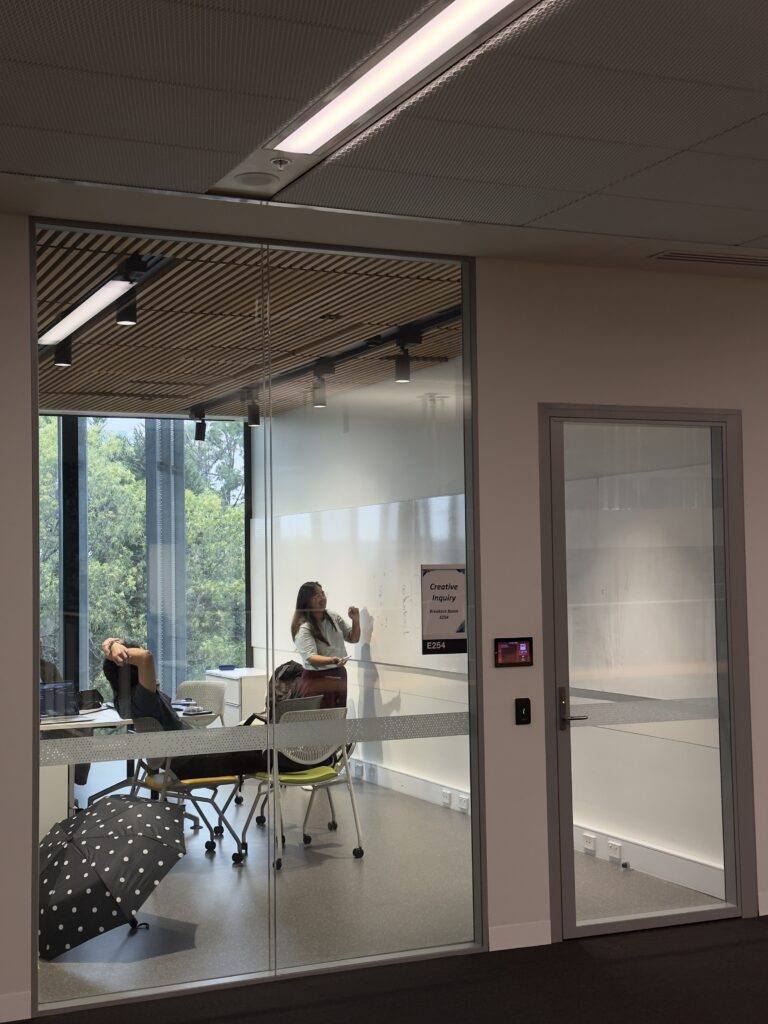Introduction
Today, I’ll be sharing my experience, thoughts, and why I think it’s worth attending the EAP (English for Academic Purposes) program at QUT.
The content will be divided into:
- QUT Learning Environment
- Teaching Staff and Curriculum
- Assignment and Exam Difficulty Introduction
- Conclusion
My IELTS score was Overall: 6.5 L:7.0 / R:7.5 / W:5.5 / S:6.5.
Since my Writing score didn’t meet the 6.0 requirement, I had to attend a language program. 🙂↕️
After consulting with friends who had attended EAP2, they said it was quite worthwhile as the curriculum was tailored for Taiwanese students, whose weakest area is often writing, which requires critical thinking and essay structure. After careful consideration, I decided to enroll in EAP2 instead of retaking the IELTS exam.
During this process, I not only learned many academic skills but also improved my spoken fluency!
In the end, I passed the EAP2 course with a 71% score. ✌️

QUT Learning Environment
I attended the language program at the P block on QUT’s Kelvin Grove campus, which is exceptionally beautiful. The library, in particular, offers a unique experience on each floor. I enjoyed studying at the studying area, which is quiet, has artificial landscapes, and offers ample seating, making it an ideal spot to study with friends!









EAP2 Instructor Introduction
EAP2 is a 10-week course. Before the official start, there’s an Orientation day where Belinda, the Manager, introduces the EAP program to students and strongly emphasizes that the use of AI is strictly prohibited. QUT places great importance on Academic Integrity, and any AI use will result in an immediate failed. 🔥
Do not attempt to break this rule, as it will not only waste your money but also your time!
After Belinda’s speech, the teacher takes students on a campus tour. In EAP, students’ abilities vary greatly, coming from different countries. Some may have taken EAP2 before but failed to pass, while others may have excelled in other areas except for one IELTS component, prompting them to enroll in EAP.
I was fortunate to have Peter V. as my instructor, a passionate and caring teacher who genuinely cared about his students’ learning progress.
His English pronunciation, vocabulary, and grammar were never too difficult, and he didn’t have a British or Australian accent, which I greatly appreciated. What impressed me most was his approach to teaching writing: the Burger Structure. Unlike traditional English education in Taiwan that rigidly follows a fixed template, he first taught us how to structure an essay, then addressed grammar, vocabulary, and the use of cohesive devices.

The first sentence should always be the Topic Sentence, which should be relevant to the topic and answer the question (e.g., Agree or Disagree). Then, there are Support Ideas (Peter used analogies like Sauce, Meat, and Vegetable) connected seamlessly with Cohesive Devices, making the essay flow smoothly and easy to read.
Of course, practice is key, and through each writing exercise, I noticed my essay writing abilities improving significantly, thanks to the help from classmates and Peter. Peter also encouraged Peer Review, where classmates would critique each other’s work, identifying areas for improvement. This not only enhanced our speaking skills as we had to explain our critiques but also improved our critical thinking abilities!
Textbooks
There were two textbooks for EAP, but students could choose to use PDF versions and take notes on tablets instead. The content covered grammar, exercises, vocabulary, word families (noun, adjective, verb, adverb forms of a word), and reading
practice. Whether the teacher referred to the textbooks depended on their preferences. Peter often used non-textbook materials to teach, which I found refreshingly different from other instructors’ approaches!
Assignment and Exam Introduction
In EAP2, there were 3 assignments:
- Annotated Bibliography accounted for 5%
- Research Assignment Outline accounted for10%
- Research Assignment Final Draft accounted for 15%
These assignments were based on a chosen topic, with options provided by the EAP instructors. Students selected a topic of interest and then found relevant literature, summarized it, and finally wrote a personal report for the Final Draft.
My topic was:
Write a report outlining the benefits and drawbacks of pet therapy in healthcare settings. Make recommendations to healthcare providers looking to implement pet therapy.
Throughout this process, instructors taught students how to cite sources, properly quote within the text, and find useful literature. There were also many writing practice exercises to help students score higher on assignments. Assignments were graded by random markers, not the class instructor, to avoid bias. The markers would provide feedback, which students had to address in their revisions to improve their scores.
There were 2 exams:
- Midterm Exam 40%: Assessing listening, speaking, reading, and writing skills, similar to IELTS.
- Final Exam 30%: IST Writing & Seminar
For IST Writing, students listened to a 10-minute audio recording and could take notes on a blank paper (focusing only on relevant points, ignoring irrelevant information). They then read two articles, identified relevant points, and integrated all three sources into a 400-word essay. This tested critical thinking, information synthesis, and writing abilities. Without Peter’s Burger Structure, I believe this would have been extremely challenging.
This skill cannot be mastered overnight; it requires internalizing the 10 weeks of course content and assignment feedback.
The Seminar involved presenting a chosen research paper in a simple, understandable manner to a group of examinees, followed by a Q&A session. Students had the freedom to select their own papers but had to consider factors like political sensitivity, controversial topics, and public resonance.
Peter allowed ample in-class practice sessions and provided feedback.
I was pleased to score an 85 on Senimar!
Conclusion
I feel that EAP2 taught me many academic skills that traditional English education in Taiwan rarely covers, such as citing sources, the Burger Structure, referencing, and paraphrasing. These concepts are not introduced in Taiwan’s education system, so attending QUT’s EAP2 truly solidified my English skills beyond just reading and listening comprehension. I also made many great friends from different countries, experiencing cultural shocks that did not affect our friendships.
In EAP2, the key to learning effectively and happily depends on the instructors and classmates. If the instructor can provide practical advice, a clear direction for improvement, and constructive feedback on individual weaknesses, and if classmates can support and motivate each other’s progress, it creates a positive and healthy learning environment. My classmates and I became good friends, sharing meals, jokes, and outings. We could offer academic suggestions while maintaining a friendly rapport, which I believe is conducive to growth and well-being.
I hope this helps those considering enrolling in the EAP2 program!
These are my personal experiences from the 10-week course. See you next time! 👋





